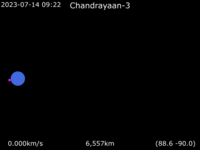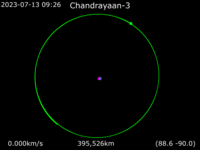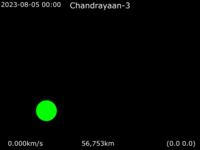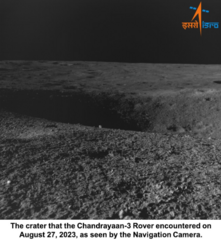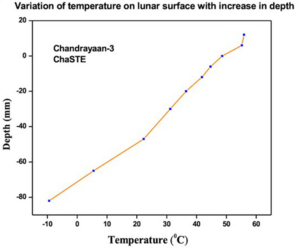Chandrayaan-3 facts for kids
| Mission type |
|
|---|---|
| Operator | ISRO |
| Mission duration | 2 years, 4 months and 24 days (elapsed)
|
| Spacecraft properties | |
| Bus | Chandrayaan |
| Manufacturer | ISRO |
| Launch mass | 3900 kg |
| Payload mass | Propulsion Module: 2148 kg Lander Module (Vikram): 1726 kg Rover (Pragyan) 26 kg Total: 3900 kg |
| Power | Propulsion Module: 758 W Lander Module: 738 W (WS with Bias) Rover: 50 W |
| Start of mission | |
| Launch date | 14 July 2023 09:05:17 UTC |
| Rocket | LVM3 M4 |
| Launch site | Satish Dhawan Space Centre |
| Contractor | ISRO |
| Moon orbiter | |
| Orbital insertion | 5 August 2023 |
| Orbit parameters | |
| Pericynthion | 153 km (95 mi) |
| Apocynthion | 163 km (101 mi) |
| Moon lander | |
| Spacecraft component | Vikram lander |
| Landing date | 23 August 2023 12:32 UTC |
| Landing site | Shiv Shakti point
69°22′23″S 32°19′08″E / 69.373°S 32.319°E (between Manzinus C and Simpelius N craters) |
| Moon rover | |
| Landing date | 23 August 2023 |
| Distance covered | 8 m (26 ft) |
 Mission Insignia |
|
Chandrayaan-3 is India's third exciting mission to explore the Moon. The name "Chandrayaan" means "Moon-craft" in Sanskrit. This mission was carried out by ISRO, the Indian Space Research Organisation.
Chandrayaan-3 included a special landing craft called Vikram and a small robot car called Pragyan. These were similar to the ones used in the Chandrayaan-2 mission. A part called the propulsion module carried the lander and rover all the way to the Moon's orbit.
The mission launched on July 14, 2023. The Vikram lander and Pragyan rover successfully landed near the Moon's south pole on August 23, 2023. This made India the first country to land a spacecraft near the lunar south pole. It also made India the fourth country ever to successfully land on the Moon.
Contents
Why Chandrayaan-3?
After the Chandrayaan-2 mission in 2019, ISRO planned Chandrayaan-3. Chandrayaan-2 had an orbiter, a lander, and a rover. Sadly, the lander from Chandrayaan-2 crashed when it tried to land on the Moon.
Because of this, Chandrayaan-3 was designed to try again. It aimed to achieve a safe landing and explore the Moon's surface. The European Space Agency (ESA) helped by providing tracking support for the mission.
What Were the Goals?
ISRO had three main goals for the Chandrayaan-3 mission:
- To land the Vikram lander safely and softly on the Moon's surface.
- To show that the Pragyan rover could drive and explore on the Moon.
- To do experiments on the Moon's surface. These experiments would help scientists learn more about what the Moon is made of.
How Was the Spacecraft Built?
Chandrayaan-3 was made of three main parts:
The Propulsion Module
This part carried the lander and rover into orbit around the Moon. It looked like a box with a large solar panel to get power from the sun. It also had a special structure on top to hold the lander.
The Vikram Lander
The Vikram lander was designed to make a soft landing on the Moon. It was also box-shaped, with four strong legs for landing. It had four engines to help it slow down and land gently. The lander carried the Pragyan rover and other science tools.
The Chandrayaan-3 lander was improved from the Chandrayaan-2 one. It had better engines that could change their power. It could also adjust its position more quickly during landing. Stronger landing legs and backup systems were added to make sure it could survive the landing.
The Pragyan Rover
The Pragyan rover is a small, six-wheeled robot car. It weighs about 26 kilograms (57 pounds). It's about 917 mm long, 750 mm wide, and 397 mm tall.
The rover's job was to take many measurements. It helped scientists study the Moon's surface and look for water ice in the soil. It also helped understand the Moon's history and its thin atmosphere.
Science Tools (Payloads)
Each part of Chandrayaan-3 carried special tools to do experiments:
Lander Tools
- Chandra's Surface Thermophysical Experiment (ChaSTE): This tool measured how well heat moves through the Moon's surface. It also checked the temperature at different depths.
- Instrument for Lunar Seismic Activity (ILSA): This measured any shaking or "moonquakes" around the landing site.
- Langmuir Probe (LP): This estimated the density of charged particles (plasma) near the Moon's surface.
Rover Tools
- Alpha Particle X-Ray Spectrometer (APXS): This found out what chemicals the lunar surface is made of.
- Laser-Induced Breakdown Spectroscope (LIBS): This tool used a laser to identify elements like magnesium, aluminum, silicon, and iron in the Moon's soil and rocks.
Propulsion Module Tool
- Spectro-polarimetry of Habitable Planet Earth (SHAPE): This tool studied Earth from lunar orbit. It looked at light from Earth to learn more about our planet.
The Mission's Journey
Launch Day
Chandrayaan-3 launched on July 14, 2023. It lifted off from the Satish Dhawan Space Centre in Sriharikota, India. The rocket used was an LVM3-M4. It first went into an orbit around Earth.
Journey to the Moon
After several steps to raise its orbit around Earth, Chandrayaan-3 began its journey to the Moon. On August 5, ISRO successfully put the spacecraft into orbit around the Moon. This was done from their control center in Bengaluru.
On August 17, the Vikram lander separated from the propulsion module. This was the start of the final phase of the mission.
The Landing
On August 23, 2023, the Vikram lander began its descent. Its engines fired to slow it down as it approached the Moon's surface. It hovered for a short time to find the best landing spot. Finally, it touched down softly at 12:32 UTC.
| Stage and sequence | Date/ Time (UTC) |
LAM burn time | Orbit | Orbital period | References |
|---|---|---|---|---|---|
| Earth orbit: Launch | 14 July 2023 | N/A | 170 km × 36,500 km (110 mi × 22,680 mi) | N/A | |
| Earth bound maneuvers: 1 | 15 July 2023 | N/A | 173 km × 41,762 km (107 mi × 25,950 mi) | N/A | |
| Earth bound maneuvers: 2 | 17 July 2023 | N/A | 226 km × 41,603 km (140 mi × 25,851 mi) | N/A | |
| Earth bound maneuvers: 3 | 18 July 2023 | N/A | 228 km × 51,400 km (142 mi × 31,938 mi) | N/A | |
| Earth bound maneuvers: 4 | 20 July 2023 | N/A | 233 km × 71,351 km (145 mi × 44,335 mi) | N/A | |
| Earth bound maneuvers: 5 | 25 July 2023 | N/A | 236 km × 127,603 km (147 mi × 79,289 mi) | N/A | |
| Trans-lunar injection | 31 July 2023 | N/A | 288 km × 369,328 km (179 mi × 229,490 mi) | N/A | |
| Lunar bound maneuver:1 (Lunar orbit insertion) | 5 August 2023 | 1,835 s (30.58 min) | 164 km × 18,074 km (102 mi × 11,231 mi) | Approx. 21 h (1,300 min) | |
| Lunar bound maneuvers: 2 | 6 August 2023 | N/A | 170 km × 4,313 km (106 mi × 2,680 mi) | N/A | |
| Lunar bound maneuvers:3 | 9 August 2023 | N/A | 174 km × 1,437 km (108 mi × 893 mi) | N/A | |
| Lunar bound maneuvers:4 | 14 August 2023 | N/A | 150 km × 177 km (93 mi × 110 mi) | N/A | |
| Lunar bound maneuvers:5 | 16 August 2023 | N/A | 153 km × 163 km (95 mi × 101 mi) | N/A | |
| Lander deorbit maneuvers: 1 | 18 August 2023 | N/A | 113 km × 157 km (70 mi × 98 mi) | N/A | |
| Lander deorbit maneuvers: 2 | 19 August 2023 | 60 s (1.0 min) | 25 km × 134 km (16 mi × 83 mi) | N/A | |
| Landing | 23 August 2023 12:32 |
TBC | N/A | N/A | |
| Rover deployment | 23 August 2023 | N/A | N/A | N/A |
How Long Did the Mission Last?
- Propulsion Module: This part was designed to work for up to 6 months in lunar orbit.
- Lander Module: The Vikram lander was expected to work for one lunar day. This is equal to about 14 Earth days.
- Rover Module: The Pragyan rover was also designed to work for one lunar day (14 Earth days).
Who Was on the Team?
Many talented people worked on Chandrayaan-3. Here are some of the key leaders:
- ISRO Chairperson: S. Somanath
- Mission Director: S. Mohanakumar
- Project Director: P. Veeramuthuvel
- Deputy Project Director: Kalpana. K
What Did Chandrayaan-3 Discover?
After landing, the Pragyan rover began exploring the Moon's surface. It sent back amazing videos and started its scientific work.
On August 25, 2023, ISRO shared the first video of the rover. It showed Pragyan rolling down a ramp from the Vikram lander. The rover then drove onto the Moon's surface. ISRO also shared videos of the lander approaching its landing site. The rover's science tools were turned on, and it moved eight meters.
On August 27, the rover found a 4-meter wide crater in its path. But don't worry, the rover safely changed direction and continued its journey!
Moon's Temperature Secrets
ISRO released exciting data from the ChaSTE tool on the lander. This tool measured the Moon's surface temperature. It found a huge difference in temperature just above and below the surface.
The data showed that the surface temperature was over 50 degrees Celsius. But just a few millimeters below, it dropped to nearly -10 degrees Celsius! This means the Moon's topsoil doesn't conduct heat very well. It acts like an insulator, keeping the heat from going deeper. This was the first time scientists got direct measurements of temperatures near the Moon's south pole.
Finding Sulphur and Other Elements
On August 29, the LIBS tool on the Pragyan rover made a big discovery. It confirmed the presence of Sulphur on the Moon's surface near the south pole. This was the first time Sulphur was directly found there!
The rover also found other elements. These included Aluminum, Calcium, Iron, Chromium, Titanium, Manganese, Silicon, and Oxygen. Scientists are still looking for Hydrogen.
What Did People Say?
India's Prime Minister, Narendra Modi, congratulated the ISRO team. He announced that the landing spot of the Vikram lander would be called Shiv Shakti point. He also declared August 23, the day of the landing, as National Space Day in India.
See also
 In Spanish: Chandrayaan-3 para niños
In Spanish: Chandrayaan-3 para niños
- Moon landing
- LUPEX
- Chandrayaan-2
- Indian Space Research Organisation
- List of missions to the Moon
- Chandrayaan-1
- Indian Human Spaceflight Programme – India's plan for human spaceflight
- Aditya-L1 – India's mission to study the Sun
- Gaganyaan – India's crewed spacecraft project


